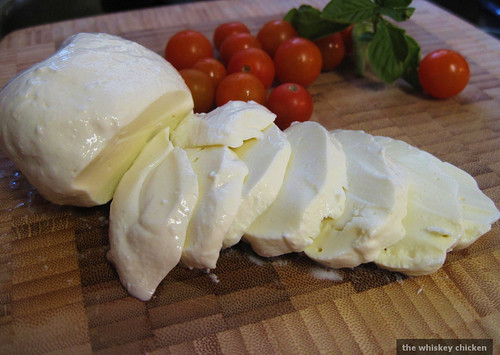This time of year is the pinnacle of tomato season. And with an overabundance of those acidic red orbs, comes a plethora of dishes that include basil and mozzarella. Now, while I admit that this trio has been overused much in the same way prosciutto and cantaloupe/asparagus has (and oh how it has...), there is a very good reason for it. It's tasty. You may be thinking Caprese salad, I am thinking pizza, but I am always thinking pizza. I like all sorts of
You could always spring for the stuff packed in water that's $9 a container, or you could make your own. Now, there are a few specialty ingredients needed to make fresh mozzarella, and you will probably need to order them off of the Internet. But most will last you for a long time, aren't terribly pricey, and can be used to make countless other cheeses. The New England Cheese Making Supply Co. is my personal favorite for such business.
I would like to share with you how to make crazy delicious mozzarella at home, but first, I want to answer a few burning questions I know you have always had about the ingredients to come.
Q. What is rennet? Why the &*@! is it in my cheese?
A. Rennet is a mixture of enzymes that are traditionally derived from the stomach of a calf (or kid, or lamb) that aid in the coagulation of cheese, causing the milk to separate into curds (milk solids/future cheese) and whey (leftover liquid). It is usually the byproduct of the veal industry. Rennet can be bought as either a liquid, powder, or tablet. There is also vegetable rennet, microbial rennet, and Chymosin (or genetically engineered rennet). Vegetable rennet can be made from a number of things such as thistle and nettle, but is most commonly mold based for commercial rennet. Microbial rennet is also mold based, and can be very difficult to use in aged cheeses due to it's bitter taste. Chymosin is a rennet who's origins start as cow genes that are then spliced into bacteria to create a genetically modified rennet that can be considered suitable for vegetarians. Junket rennet tablets are a very weak form of rennet that will not work for aged cheeses. Besides, it has Junk in the name.
Q. What is Calcium Chloride?
A. Calcium Chloride is a salt solution that is used to restore the balance of calcium that is lost to heat treatment in milk. It helps to speed up the coagulation process when rennet is used.
Q. What is cheese salt? Sounds delicious...
A. Cheese salt is simply an noniodized coarse salt that is used to flavor the cheese. It is not cheese flavored salt. Kosher salt can also be used, as long as it is iodine free. Iodine inhibits lactic bacteria and slows down the aging process.
Fresh Mozzarella
Ingredients
1 1/2 teaspoons calcium chloride dissolved in 1/2 cup cool water
1 gallon pasteurized whole milk (if using raw milk, skip calcium chloride)
1/4 teaspoon liquid rennet dissolved in 1/4 cup cool, nonchlorinated water
1 teaspoon cheese salt
Special Equipment
large stainless steel pot
stainless steel slotted spoon
thermometer
heavy duty latex or rubber gloves
Pour milk into pot over medium/low heat.
When milk reaches 55 degrees, stir in calcium chloride mixture.
Heat milk to 90 degrees (milk will start to curdle).
Slowly stir in rennet mixture in an up and down motion while heating milk to 100 degrees.
Turn off heat.
When the curds get larger, start to pull away from the pot, and the whey is fairly clear, they are ready (3-5 minutes).
Using the slotted spoon, scoop out curds into a microwave safe bowl.
Press the curds to expel as much of the whey as possible.
Microwave the curds for 1 minute.
Put on gloves (trust me) and drain off whey, then knead curds as you would dough. Very, very hot dough.
Microwave two more times for 35 seconds each, kneading after each time.
Add salt after last heating and knead until curds stretch like taffy.
Roll curds into balls or squeeze in between the hole of your index finger and thumb as if you were making a cheese balloon, then pinch with thumb.
Eat right away while still warm and gooey, or store in water in refrigerator for up to a week.
 |
| Just add face |

"Why the &*@! is it in my cheese?" Is officially going to be my go to statement when things don't seem right.
ReplyDeleteHahaha! It can pretty much sum up any given situation.
ReplyDeleteOne of the joys of making mozza is that you have whey left over. http://www.instructables.com/id/Great-Ricotta-Cheese-From-Whey/ explains how to make ricotta from it *grin*
ReplyDeleteI truly like to reading your post. Thank you so much for taking the time to share such a nice information.
ReplyDeletecheese making supplies